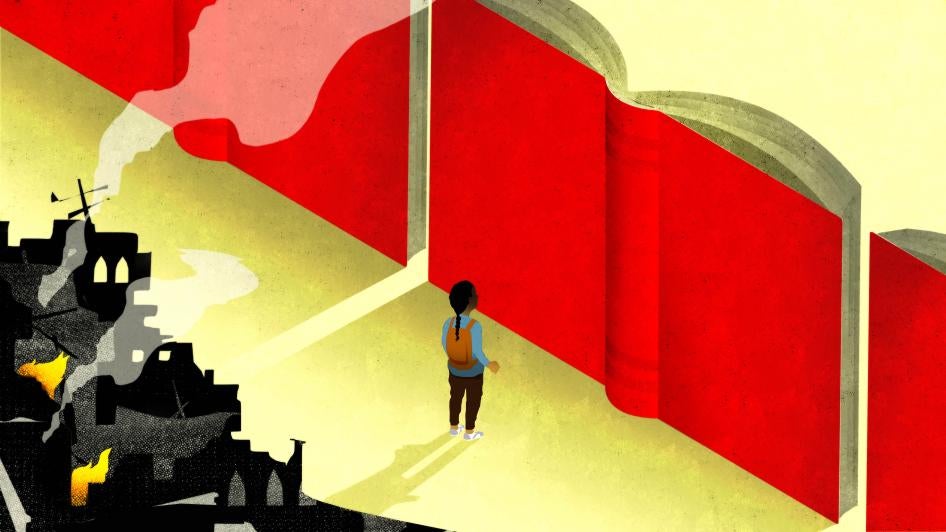(Beirut) – Donor governments should address the unprecedented education crisis in Lebanon at the funding conference on May 10, 2022, in Brussels, the Center for Lebanese Studies and Human Rights Watch said today. Public schools for hundreds of thousands of Lebanese and Syrian students have largely been closed for the last three school years.
Donors at the annual humanitarian conference for Syria and countries hosting Syrian refugees should press Lebanon to change policies that prevent aid from reaching schools and students. That includes the central bank’s practice of keeping most of the value of humanitarian aid by manipulating currency exchange rates at the time of withdrawal. The Education Ministry should publish data on student enrollment and attendance and end restrictions on access to schooling for refugee students. Donors should also meet regularly with representatives of Lebanese teachers, who have been on strike for most of the year over compensation grievances.
“Donors have plowed more than a billion dollars of humanitarian aid for education into Lebanon over five years, yet we have seen an avoidable and worsening education disaster,” said Dr. Maha Shuayb, director of the Center for Lebanese Studies. “The watchword of the Brussels conference should be accountability.”
Since October 2019, schools have been largely closed following protests against government corruption, the Beirut port explosion, the Covid-19 pandemic, rising xenophobia, and teachers’ strikes as the economic crisis devalued their salaries by 90 percent. In 2021-22, public schools had been open for only 34 days as of March 31, including days when schools were “only half-operational,” according to humanitarian monitoring.
During the previous school year, at least 700,000 of 2 million school-age children in Lebanon were out of school, humanitarian education agencies reported. In some areas, child labor rates rose to 45 percent. Primary education is compulsory under Lebanese law and the United Nations Convention on the Rights of the Child.
Donor governments and Lebanon promised in 2016 that all Syrian refugee children would have access to education, but targets shrunk to a goal of enrolling just 202,000 out of the 715,000 school-age Syrian children this year. More than 80 percent of Syrian girls and women aged 15-24 are not in any form of education, training, or employment.
From 2017 through 2021, donors gave more than $1.12 billion for education programs included in the Lebanon Crisis Response Plan, which guides the international humanitarian response to the 1.5 million Syrian refugees who fled to Lebanon after 2011. More than half of these funds were directed to Lebanon’s Education Ministry.
But donors transfer the funds in US dollars to Lebanon’s central bank, which takes most of the value of the aid before it reaches its beneficiaries by setting artificially low exchange rates for withdrawals in Lebanese currency. As of December 2021, the bank's rate was 8,000 Lebanese pounds per dollar, compared with the market exchange rate of between 25,000 and 30,000 pounds. In previous months, the bank's rate was even lower, at 3,900. Some humanitarian donors had reportedly negotiated marginally better exchange rates.
Donors should also press Lebanon to raise limits on bank withdrawals for schools, the Center for Lebanese Studies and Human Rights Watch said. Some principals said they cannot withdraw more than 3 million pounds per month, or roughly $110, leaving schools unable to pay for electricity, fuel, or janitors’ wages, despite donor support. “There is no electricity, there is no internet, there is no money,” one principal said. Teachers went on strike against the withdrawal limits, among other grievances, on April 27.
The Education Ministry should regularly publish data on student enrollment, attendance, and dropouts. The ministry operates a donor-funded School Information Management System that can track each student’s daily attendance, but it has not published any data, which is crucial for education planning. “How do you plan catch-up programs after three years of little schooling, when we don’t know the drop out or learning rates per area, or the impact of learning losses on outcomes,” an education expert at an aid group said.
Enrollment is also linked to funding, as donors give Lebanon a set dollar amount for each Syrian student enrolled in public schools. A May 2020 investigative news report found that fewer Syrian children were attending schools than the Education Ministry had stated, leaving it with a surplus of at least $7 million in donor funding for Syrian students in the 2019-20 school year.
For the first time, the Education Ministry plans in 2022 to provide donors with its full budget including all incoming funds and expenditures, officials with knowledge of the issue told the Center for Lebanese Studies and Human Rights Watch. This data should be made public. Donors should continue to consider ways to give money directly to schools to avoid delays and corruption.
Donor government officials should also hold regular meetings with representatives of Lebanon’s teachers, whose grievances remain unresolved. Most public school teachers work on temporary contracts for $1.50 to $2.50 (40,000 - 68,000 Lebanese pounds) per hour, while teachers with permanent contracts typically earn from $45 to $95 (1.5 - 2.5 million pounds) per month at primary and secondary schools, teachers said. In addition, some teachers on temporary contracts said they were paid late or went for months without pay in late 2021 and early 2022. The government’s response to teacher strikes now includes “incentives” like transportation subsidies and $90 per month in “social assistance.” But teachers voiced distrust that the Education Ministry allocated donor funding equitably, and said they were promised a salary raise that had not materialized.
Donor support is needed for teachers to receive adequate compensation to live on, while avoiding further disruptions after years of lost learning. In late April, teachers demanded a reduction in the school week from five days to three and to finish the school year early due to insufficient compensation. The Education Ministry has reduced the school curriculum by 50 percent, for the second year in a row. But it has not presented a plan that addresses the impact of ongoing teachers’ strikes after years of lost learning, teachers and education aid groups said. Nearly all of the 217 public school teachers surveyed by the Center for Lebanese Studies in February believed strikes were the only action that could lead to change.
Finally, donors should press the Education Ministry to remove barriers to education, especially for refugee students. The ministry has claimed that all refugee children can enroll but has not clearly instructed school principals to accept all Syrian students who seek to enroll or to allow Syrian students to take national examinations and receive their grades. As a result, principals have arbitrarily rejected Syrian students because they supposedly lacked certain documents that very few have, such as legal residency in Lebanon. “A simple decision by the [education] ministry requiring all children be accepted and only imposing placement tests as need be, could resolve these problems tomorrow,” said an education expert at a humanitarian agency.
Syrian children have also been refused enrollment by principals who claimed their schools were “full,” even though most schools had the capacity to accept more students at the time, school monitoring found. Other schools were closed during the registration period due to teacher strikes. An aid worker said that some Syrian families “go to one school, then another, and by the third they give up” trying to enroll their children. A UN-supported complaints system for enrollment problems has proven ineffective because the Education Ministry does not share how or if it has responded to the complaints, humanitarian groups said.
Humanitarian groups that run nonformal education programs say the ministry has still not said if or how it will allow these students to transition to formal education. In past years such guidance has been provided months late or not at all. “I started working on education in 2014 and we were waiting for [guidance] then, and I’m still waiting,” an aid group official said in March.
With Lebanon’s economic collapse, foreign funding for education is more important than ever, yet humanitarian aid to education education has fallen since 2018, the Center for Lebanese Studies and Human Rights Watch said. The education budget in the 2022 donor-funded humanitarian plan for Lebanon is $182 million, higher than Lebanon’s entire planned education budget of $125 million (3.39 trillion pounds).
“Children in Lebanon can’t afford having another year of education stolen from them by government bungling and an international community that shrugs at bad results,” said Bill Van Esveld, associate children’s rights director at Human Rights Watch. “At minimum, donors at the Brussels conference should set out the specific steps that Lebanese authorities need to take to fulfill the right to education.”









